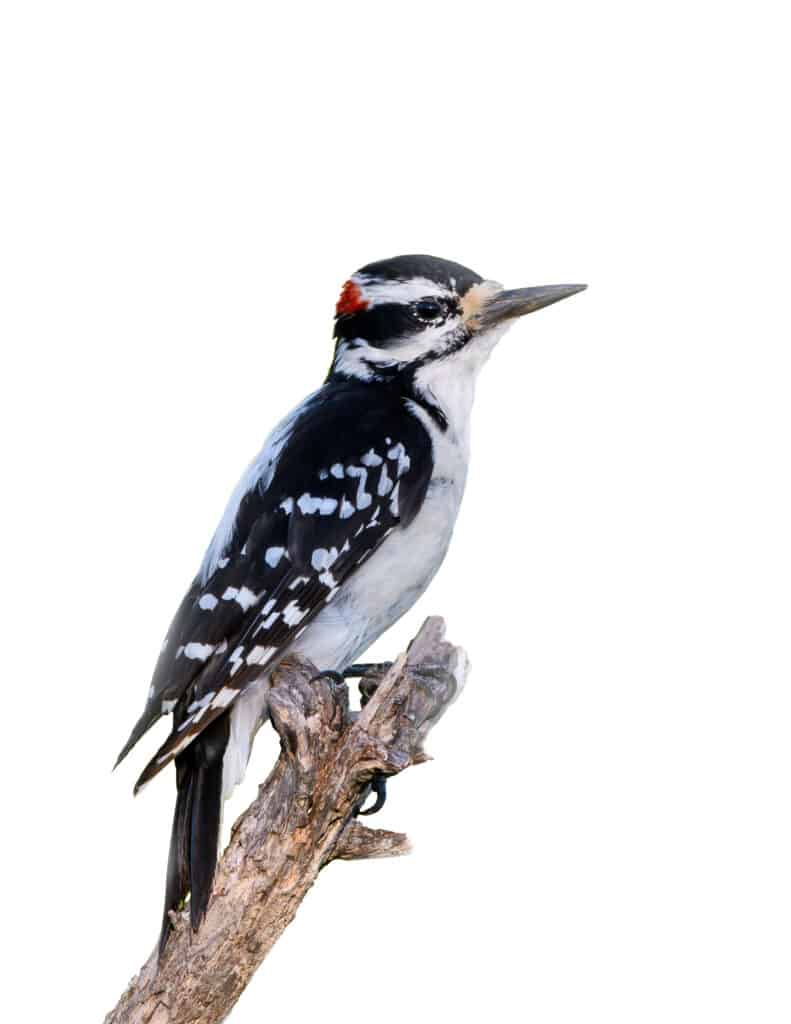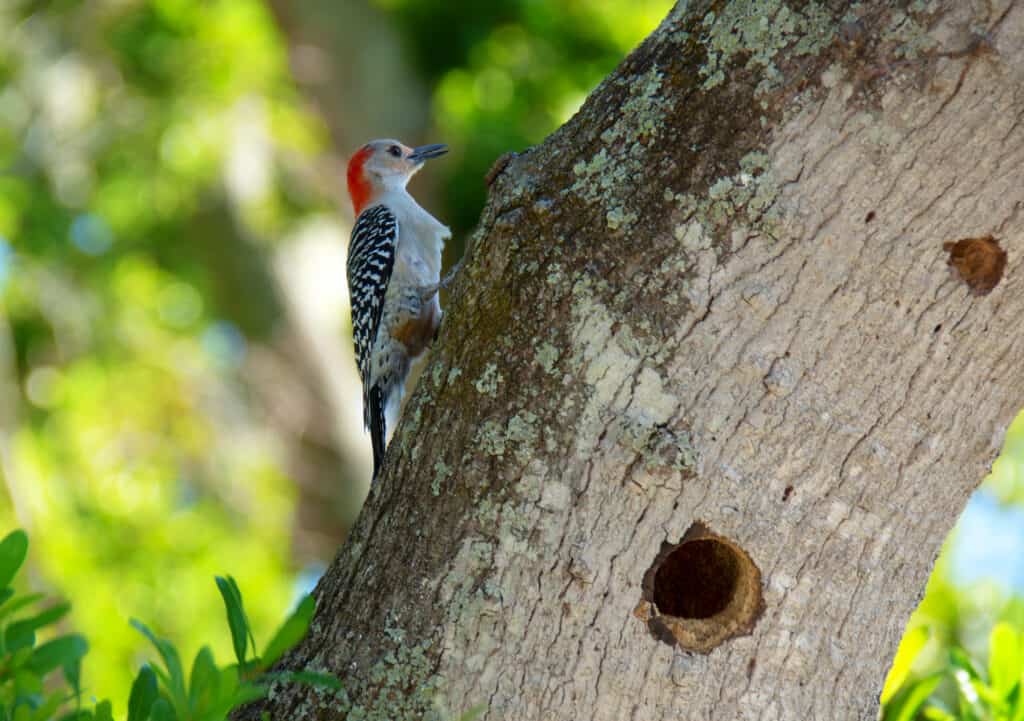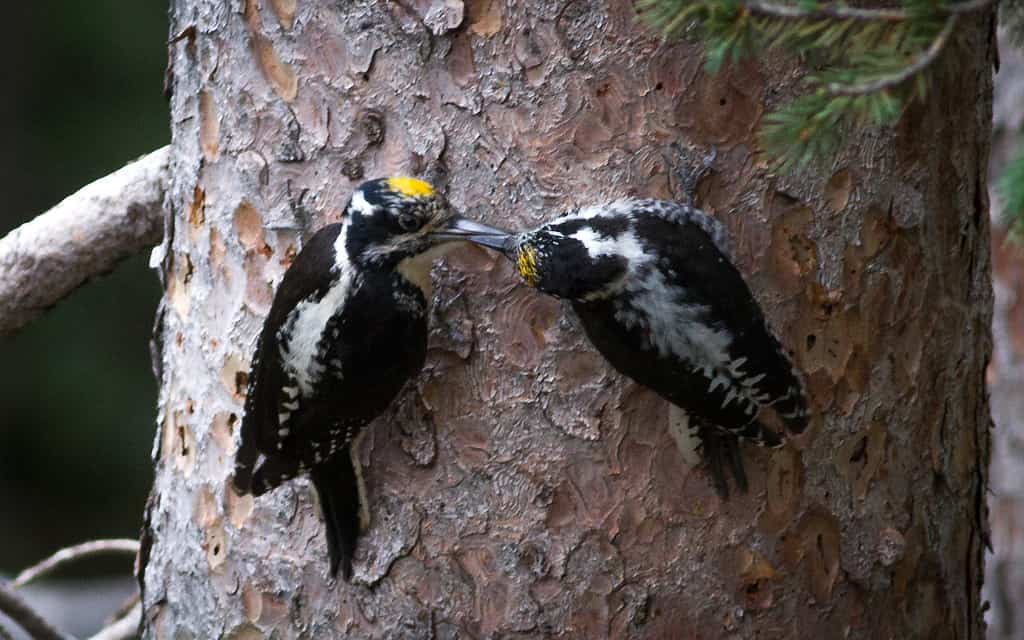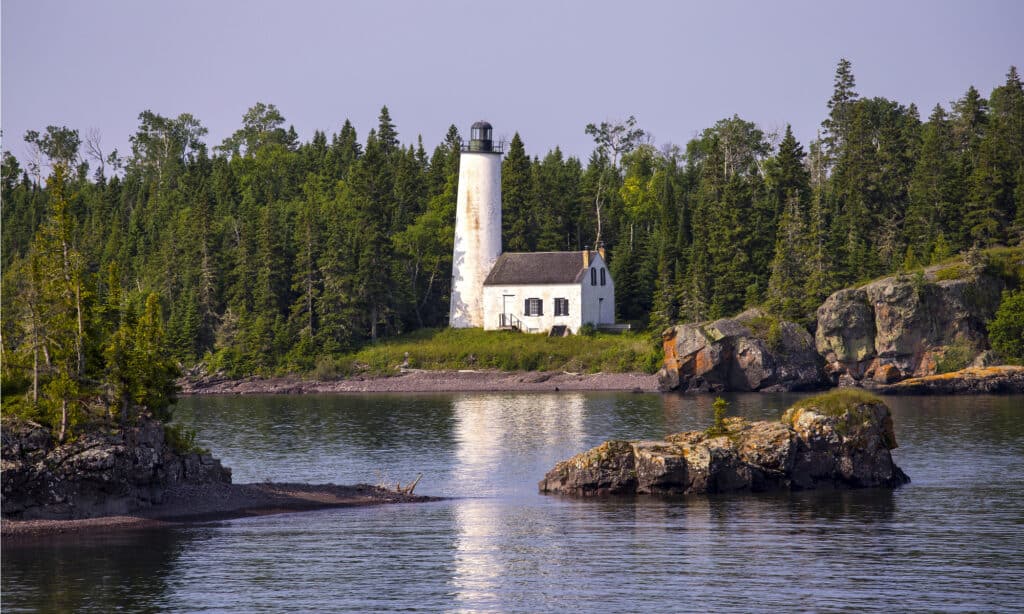Michigan is home to several woodpecker species. Each has its own unique characteristics that help set it apart from the others. Michigan has a very diverse landscape that helps provide suitable habitat for many bird species, including many types of woodpeckers.
Woodpeckers are sometimes considered pests. However, they play a major role in Michigan’s ecosystem. They help with insect control, tree aeration, and creating nesting sites. Many birds use their holes after the woodpecker moves on.
In this article, we’ll explore the different woodpecker species found in Michigan, delve into their unique markings, and provide insights into the specific areas of the state where you’re most likely to encounter them.
1. Downy Woodpecker

This species is extremely small.
©Jim Nelson/Shutterstock.com
In Michigan’s wooded areas, the Downy Woodpecker is a familiar sight. It is the smallest woodpecker in North America and has a striking black-and-white plumage pattern. The woodpecker’s dark upper parts contrast beautifully with its distinctive white undersurface.
Males have an additional touch of charm with a small red patch on the back of their heads. At only 6-7 inches in length, the Downy Woodpecker can be found in forests, parks, and even suburban areas.
It is a versatile and adaptable bird due to its small size, which allows it to easily navigate through twigs and branches.
2. Hairy Woodpecker

Hairy woodpeckers have white checkered spots on their wings.
©FotoRequest/Shutterstock.com
While the hairy woodpecker looks surprisingly like a Downy Woodpecker, it is a completely different species. It exhibits many of the same plumage coloration, which can make it challenging to identify.
However, this woodpecker is slightly larger at around 7-10 inches. It is black and white with a white undersurface and a red patch on the male’s head.
These woodpeckers live in mature forests, woodlands, and urban areas. You’ll often find them in suburban gardens and parks, as they live perfectly fine next to people. It is a frequent visitor to bird feeders.
3. Red-bellied Woodpecker

Red-bellied woodpeckers are quite common in Michigan.
©Michael O’Keene/Shutterstock.com
Despite its name, the Red-bellied Woodpecker displays a modest red hue on the back of its head. It is an interesting species with black-and-white plumage with zebra-like wing patterns. It stands out in both appearance and behavior, making it easy to identify.
This species can often be spotted in wooded areas such as forests, woods, and even suburban neighborhoods. Its foraging habits include probing tree bark for insects and using its powerful beak to excavate crevices for nesting.
4. Northern Flicker

Northern Flickers are an unusual-looking species.
©Fiona M. Donnelly/Shutterstock.com
The Northern Flicker doesn’t have the usual black-and-white color scheme. Instead, they have a brownish body with black bards on their backs. They’re also quite large, though not necessarily the largest woodpecker.
They’re most recognizable by their “V” shape on their back. The underside of their wings and tails are also yellow, making them easy to see in flight.
The Northern Flicker prefers more open habitats like fields and grasslands. They differ from other woodpeckers for this reason.
5. Pileated Woodpecker

The largest woodpecker species in North America, the pileated woodpecker rarely nest in the same tree twice.
©Vlad G/Shutterstock.com
The Pileated Woodpecker is the largest woodpecker in North America. They’re pretty easy to identify just because they are so large! They also have a striking white-and-black body with a bright rest crest.
These woodpeckers prefer forests with mature, large trees. They excavate holes for their nests, which end up being quite large. They will also create large holes in trees in search of insects, which other animals will use for nesting purposes.
They’re a rarer sight, but if you see one, it’s easy to know what you’re looking at.
6. Yellow-bellied Sapsucker

These amazing birds use multiple calls to communicate with each other.
©iStock.com/impr2003
The Yellow-bellied sapsucker is one of the most colorful woodpeckers. They have distinctive plumage with a red crown and white stripes all over their face. Their belly is also yellow, as their name suggests. However, it isn’t particularly vibrant.
This woodpecker’s feeding behavior is fascinating—it creates orderly rows of small holes in trees to extract sap and insects attracted to it. They can be fairly damaging to trees and are more likely to be seen as a pest.
7. American Three-toed Woodpecker

Three-toed woodpeckers only have three toes, hence their name.
The American Three-toed Woodpecker has a unique trait, hence its name. It only has three toes on each food. Its black-and-white plumage is similar to other woodpeckers, but it prefers coniferous forests (unlike most other species).
For this reason, this woodpecker is found in the northern parts of Michigan primarily. It plays a crucial role in maintaining the health of its ecosystems by eating insects and making holes for other birds to nest in.
Woodpecker Habitats in Michigan

Isle Royale National Park is a common area to spot woodpeckers in Michigan.
©Steven Schremp/Shutterstock.com
Woodpeckers are pretty common in Michigan. However, to spot one, it still helps to know where to look. Michigan offers plenty of different habitats for these birds to live in. State parks, nature reserves, and wooded suburban environments are the best places to spot woodpeckers.
In the southern part of the state, Downy and Hairy Woodpeckers are most common. The forests tend to be a mix of deciduous and coniferous trees.
If you go northward, you’ll likely find the Pileated Woodpecker and American three-toes Woodpecker. These birds prefer more mature forests, where their evacuation abilities really allow them to thrive.
In both urban and rural settings, the Red-bellied Woodpecker is a frequent visitor. Its knack for adapting to various habitats makes it a versatile species that can be observed even in your local neighborhood.
The Northern Flicker is more common in open areas, where it won’t encounter many other woodpeckers. It also likes suburban yards with lots of vegetation.
Summary of Woodpeckers in Michigan
| Number | Species |
|---|---|
| 1 | Downy Woodpecker (Picoides pubescens) |
| 2 | Hairy Woodpecker (Picoides villosus) |
| 3 | Red-bellied Woodpecker (Melanerpes carolinus) |
| 4 | Northern Flicker (Colaptes auratus) |
| 5 | Pileated Woodpecker (Dryocopus pileatus) |
| 6 | Yellow-bellied Sapsucker (Sphyrapicus varius) |
| 7 | American Three-toed Woodpecker (Picoides dorsalis) |
The photo featured at the top of this post is © Vlad G/Shutterstock.com
Thank you for reading! Have some feedback for us? Contact the AZ Animals editorial team.







